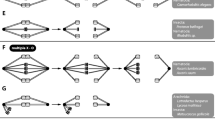Abstract
The sex chromosomes segregate precociously in prometaphase I of male meiosis, without prior synapsis or any physical connection, in 4 species of American mantispids (Neuroptera: Mantispidae). Segregational movements are interpolar, and are implemented through chromosomal fibers. Univalent autosomes, present from diakinesis on in several species, are capable of a similar distance segregation in prometaphase. The sex chromosomes are XX ♀ —XY ♂, as is characteristic of the Order, with the exception of Entanoneura phthisica in which both elements are compound —X1X2X3Y1Y2Y3in the male, and X1X1X2X2X3X3 in the female. In tetraploid sectors of gonial origin in testes of this species no sex bivalents are formed; a distance segregation of 6 sex univalents to each pole is effected, but — as observed in the one individually identifiable pair — segregation separates complete homologues, Y1 from Y1, X1 from X1, etc. In all species the male meiotic spindle is formed by the collocation of individual chromosomal spindle units within which bivalents become deformed; the timing and degree of deformation vary with the species. In karyotype the American species conform to a common pattern with the known Japanese and European species; diploid numbers range only from 18 to 22, and each complement carries the family insigné of one pair of disproportionately large autosomes in a set of small and rather uniformly sized chromosomes.
Similar content being viewed by others
References
Bauer, H., R. Dietz u. C. Röbbelen: Die Spermatocytenteilungen der Tipuliden. III. Das Bewegungsverhalten der Chromosomen in Translokationsheterozygoten von Tipula oleracea. Chromosoma (Berl.) 12, 116–189 (1961).
Camenzind, R., and R. B. Nicklas: The non-random segregation in spermatocytes of Gryllotalpa hexadactyla. A micromanipulation analysis. Chromosoma (Berl.) 24, 324–335 (1968).
Dietz, R.: Multiple Geschlechtschromosomen bei dem Ostracoden Notodromus monacha. Chromosoma (Berl.) 6, 397–418 (1954).
— Die Spermatocytenteilungen der Tipuliden. II. Graphische Analyse der Chromosomenbewegung während der Prometaphase I im Leben. Chromosoma (Berl.) 8, 183–211 (1956).
— Centrosomenfreie Spindelpole in Tipulidenspermatocyten. Z. Naturforschg. 14b, 749–752 (1959).
Hirai, H.: Notes on the chromosomes of the Osmyloidea (Neuroptera). Misc. Rep. Yamashina's Inst. Ornith. Zool. 6, 269–270 (1955).
— Cytotaxonomic studies of the Japanese Neuroptera I. The Osmyloidea. Jap. J. Gen. 31, 54–64 (1956a).
— Compound sex chromosomes with distance pairing in the male neuropteran, Plethosmylus decoratus. Annot. Zool. Jap. 29, 155–160 (1956b).
Hughes-Schrader, S.: Reproduction in Acroschismus wheeleri Pierce. J. Morph. Physiol. 39, 157–205 (1924).
— Cytology of coccids (Coccoidea-Homoptera). Advanc. Genet. 2, 127–203 (1948).
Kichijo, H.: The chromosomes of some neuropterous insects of the family Chrysopidae. J. Fac. Sci. Hokkaido Imp. Univ. 3, 55–65 (1934).
Klingstedt, H.: Chromosome behavior and phylogeny in the Neuroptera. Nature (Lond.) 139, 468–469 (1937).
Lorbeer, G.: Die Zytologie der Lebermoose mit besonderer Berücksichtigung allgemeiner Chromosomenfragen. Jb. wiss. Bot. 80, 567–818 (1934).
Naville, A., et J. de Beaumont: Recherches sur les chromosomes des Névroptères I. Arch. Anat. micr. 29, 199–243 (1933).
— Recherches sur les chromosomes des Névroptères II. Arch. Anat. micr. 32, 271–302 (1936).
Piza, S. de T.: Una nova modalidade de sexo-determinaçaña no grilo Sul-Americano Eneoptera surinamensis. Anais Escola Sup. Afric. “Luiz de Queiroz” 3, 68–88 (1946).
Schrader, F.: The spermatogenesis of the earwig Anisolabis maritima Bon. with reference to the mechanism of chromosomal movement. J. Morph. 68, 123–147 (1941).
Smith, S. G.: The cytology of some tenebrioned beetles (Coleoptera). J. Morph. 91, 325–364 (1952).
— A pseudo-multiple sex chromosome mechanism in an Indian gryllid. Chromosoma (Berl.) 5, 555–573 (1953).
Snow, R.: Alcoholic hydrochloric acid-carmine as a stain for chromosomes in squash preparations. Stain Technol. 38, 9–13 (1963).
Suomalainen, H. O. T.: Occurrence and phylogenetic significance of a true sex chromosome bivalent in a lacewing, Boriomyia nervosa F. (Neuroptera; Hemerobiidae). Arch. Soc. “Vanamo” 7, 45–49 (1952).
Virkki, N.: Orientation and segregation of asynaptic multiple sex chromosomes in the male Omophoita clerica Erichson (Coleoptera: Alticidae). Hereditas (Lund) 57, 275–288 (1967).
White, M. J. D.: Animal cytology and evolution, 2nd edit., p. 321. London: Cambridge University Press 1954.
Whitten, M. J.: An unusual chromosome system in a leafhopper (Homoptera: Auchenorrhyncha). Chromosoma (Berl.) 24, 37–41 (1968).
Author information
Authors and Affiliations
Rights and permissions
About this article
Cite this article
Hughes-Schrader, S. Distance segregation and compound sex chromosomes in mantispids (Neuroptera: Mantispidae). Chromosoma 27, 109–129 (1969). https://doi.org/10.1007/BF00326139
Received:
Accepted:
Issue Date:
DOI: https://doi.org/10.1007/BF00326139




